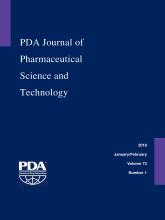Research ArticleTechnology/Application
Assessment of Extractable Elements from Elastomers
Diane Paskiet, Crystal Kraft, Erica Tullo, Jeff Hunter and Diego Zurbriggen
PDA Journal of Pharmaceutical Science and Technology January 2019, 73 (1) 83-91; DOI: https://doi.org/10.5731/pdajpst.2017.008193
Diane Paskiet
West Pharmaceutical Services, Inc. Exton, PA, USA.
Crystal Kraft
West Pharmaceutical Services, Inc. Exton, PA, USA.
Erica Tullo
West Pharmaceutical Services, Inc. Exton, PA, USA.
Jeff Hunter
West Pharmaceutical Services, Inc. Exton, PA, USA.
Diego Zurbriggen
West Pharmaceutical Services, Inc. Exton, PA, USA.

References
- 1.↵ICH Harmonised Guideline: Guideline for Elemental Impurities. Q3D. Current Step 4 Version. 2014.
- 2.↵
- Zhao S.,
- Lewis L.,
- Singh S. K.
- 3.↵
- Milano E. A.,
- Waraszkiewicz S. M.,
- Dirubio R.
- 4.↵
- Wang W.,
- Ignatius A. A.,
- Thakkar S. V.
- 5.↵
- Boven K.,
- Stryker S.,
- Knight J.,
- Thomas A.,
- van Regenmortel M.,
- Kemeny D. M.,
- Power D.,
- Rossert J.,
- Casadevall N.
- 6.↵
- Milano E. A.,
- Waraszkiewicz S. M.,
- Dirubio R.
- 7.↵
- Milano E. A.,
- Williams D. A.
- 8.↵
- Baranwal K. C.,
- Stephens H. L.
- 9.↵
- Ohm R. F.
- 10.↵
- Markovic I.
- 11.↵
- Jenke D. R.,
- Stults C. L.,
- Paskiet D. M.,
- Ball D. J.,
- Nagao L. M.
- 12.↵
- Jenke D.,
- Carlson T.
- 13.↵
- Li X.,
- Qian P.
- 14.↵
- Paskiet D.,
- Janssen R.,
- Guazzo D.,
- Ball D.
- 15.↵
- Zaidi K.
- 16.↵<231> Heavy Metals In The United States Pharmacopeia, United States Pharmacopeial Convention, Inc.: Rockville, MD, 2018; Vol. USP 40–NF 35, p. 293.
- 17.↵The Ministry of Health, Labour, and Welfare, Japanese Pharmacopoeia 16th Edition. Japan, 2016.
- 18.↵
- Agency E. M.
- 19.↵
- Commision C. P.
- 20.↵<232> Elemental Impurities-Limits. In The United States Pharmacopeia, United States Pharmacopeial Convention, Inc.: Rockville, MD, 2018; Vol. USP 40–NF 35.
- 21.↵<233> Elemental Impurities-Procedures. In The United States Pharmacopeia United States Pharmacopeial Convention, Inc.: Rockville, MD, 2018; Vol. USP 40–NF 35.
- 22.↵
- Jenke D.,
- Castner J.,
- Egert T.,
- Feinberg T.,
- Hendricker A.,
- Houston C.,
- Hunt D. G.,
- Lynch M.,
- Shaw A.,
- Nicholas K.,
- Norwood D. L.,
- Paskiet D.,
- Ruberto M.,
- Smith E. J.,
- Holcomb F.
- 23.↵
- Boltres B.,
- Tratzky S.,
- Kass C.,
- Eichholz R.,
- Nass P.
- 24.↵
- Whitman G. W.,
- Russell R. P.,
- Altieri V. J.
- 25.↵
- Dellien I.,
- Persson L.
- 26.↵
- Apak R.,
- Hizal J.,
- Ustaer C.
- 27.↵
- Butler L. C.,
- Pearson J. G.
- 28.↵
- Chaurasia A. S.,
- Singh K. K.,
- Mankhand T. R.
- 29.↵
- Rimaszeki G.,
- Kulcsar T.,
- Kékesi T.
- 30.↵
- Lichtfouse E.,
- Schwarzbauer J.,
- Robert D.
- Abarikwu S. O.
- 31.↵
- May T. W.,
- Wiedmeyer R. H.
In This Issue
PDA Journal of Pharmaceutical Science and Technology
Vol. 73, Issue 1
January/February 2019
Jump to section
Related Articles
- No related articles found.





